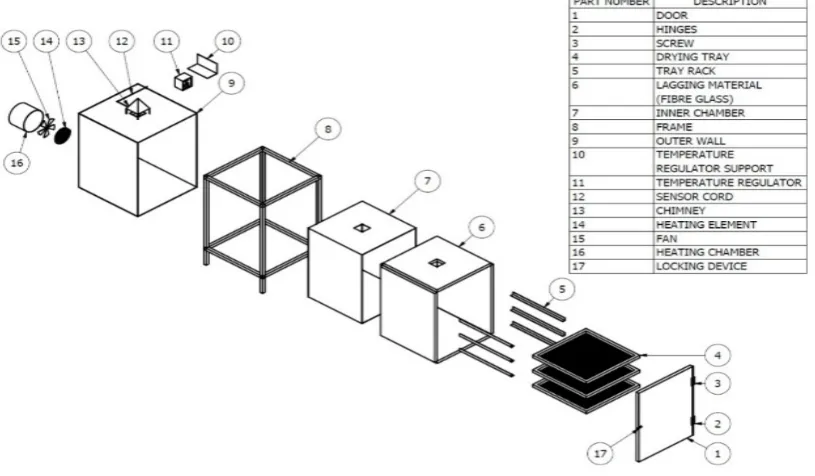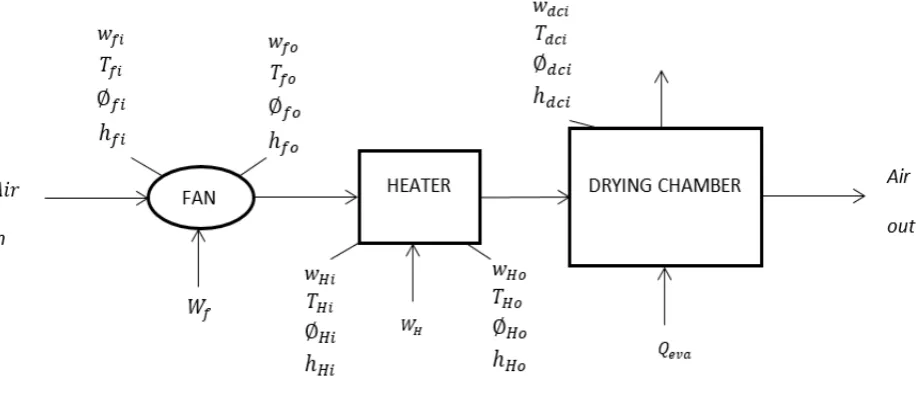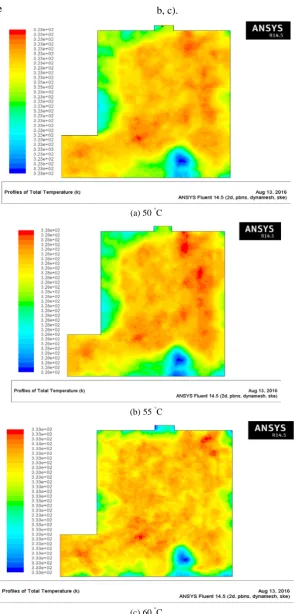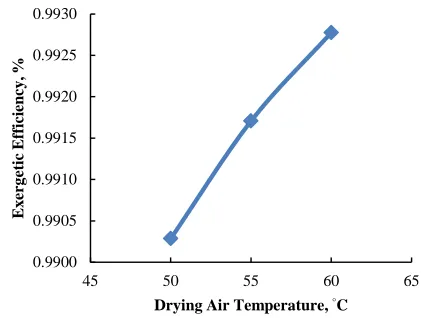Energy and exergy analyses of convective drying of green bell
pepper in a cabinet tray dryer
Michael Mayokun Odewole
1*, Peter Pelumi Ikubanni
2, Kehinde James Falua
3,
Samuel Kehinde Oyeniyi
4(1. Department of Food Engineering, Faculty of Engineering and Technology, University of Ilorin, Ilorin, P.M.B. 1515, Nigeria;
2. Department of Mechanical Engineering, Faculty of Engineering and Technology, Landmark University, Omu-Aran, P.M.B. 1001, Nigeria;
3. Department of Agricultural and Biosystems Engineering, Faculty of Engineering and Technology, University of Ilorin, Ilorin, P.M.B.1515,
Nigeria;
4. Department of Agricultural and Environmental Engineering, Faculty of Technology, University of Ibadan, Ibadan, P.M.B. 200284,
Nigeria)
Abstract: This paper presents Computational Fluid Dynamics (CFD) in the drying process of green bell pepper in a cabinet tray dryer using three drying temperatures (50 °C, 55 °C and 60 °C). Engineering simulation software ANSYS 14.5 was used to simulate the model of the dryer in 2 Dimensional (2D). The ANSYS Design Modeler modeled the 2D representation of the dryer and ANSYS ICEM was used for mesh analysis. Thereafter, the derived data from the simulation was used in the calculation of the energy and exergy analyses of the dryer based on the thermal efficiency with respect to the varied drying temperatures in order to assess the performance of the system in terms of energy utilization (EU), energy utilization ratio (EUR), energy efficiency, exergy inflow and outflow, exergy loss and exergetic efficiency. The results indicated that EU and EUR decreased from 0.02401 to 0.01975 J s-1 and 0.01441 to 0.00299 respectively as the drying air temperature increased from 50 to 60 °C. Energy efficiency decreased from 0.196% to 0.115%. Exergetic efficiency increased with increase in drying air temperature from 0.9903% to 0.9928%. Model equations that could be used to express the energy and exergy parameters as a function of drying temperature were established from this study.
Keywords: Ansysfluent, CFD, drying temperature, energy, exergy
Citation: Odewole, M. M., P. P. Ikubanni, K. J. Falua, and S. K. Oyeniyi. 2020. Energy and exergy analyses of convective drying of green bell pepper in a cabinet tray dryer. Agricultural Engineering International: CIGR Journal, 22 (1):196-203.
1 Introduction
Drying is one of the most important processes in food
processing and preservation and has been generally
defined as the removal of moisture from a material to a
predetermined level (Kumar et al., 2012). This ensures
foods are stored for longer periods in ambient
temperature than fresh foods due to the fact that
Received date: 2018-10-07 Accepted date: 2019-01-31
*Corresponding author:Michael Mayokun Odewole, Ph.D., Lecturer of Department of Food Engineering, University of Ilorin, P.M.B. 1515, Nigeria. Email: odewole2005@yahoo.com, Tel: +234(0)80-6771-5016.
microbiological activity have become reduced with
minimal physical and chemical changes (Ozgur et al.,
2011). Drying can be accomplished by several methods
such as hot air, microwave and vacuum drying (Lam et al.,
2014). The recent advances in drying technology has
brought about increase in the development of computer
programs that have the great capacity in evaluating the
drying parameters and high efficiency which gives high
impact to the cost of energy used during the operation.
Besides experimental testing, computational work
nowadays is becoming more important due to lower cost
and acceptable accuracy with minimum error. It has been
190 March, 2020 AgricEngInt: CIGR Journal Open access at http://www.cigrjournal.org Vol. 22, No. 1
adjudged that Computational Fluid Dynamics (CFD)
software reduces a lot of trial and error on experimental
work (Amanlou and Zomorodian, 2010) in that it gives
detailed account of the stringent parameters that cannot
be observed analytically since it is capable of presenting
visualized results. CFD techniques have been integrated
to dryer designs in order to solve the complexity in drying
phenomenon.
Energy and exergy in drying process deals with the
thermodynamic process which is being governed by the
first and second laws of thermodynamics. The first law
laid emphasis on the quantity of energy in a system
without consideration for the energy quality in the system
while exergy deals with the second law of
thermodynamics, which involves the reversibility and
irreversibility of thermal processes as a result of entropy
generation (Chemmala and Dinesh, 2014). Energy and
exergy analyses in drying processes had drawn interest
from researchers where different approaches and
methodologies were employed. To mention few, exergy
and energy effect was studied in a drying of a native
cassava starch (Aviara et al., 2014), and tomato slices in a
mixed mode natural convective solar dryer (Arepally et
al., 2017). Since there is few information on the energy
and exergy analyses of green bell pepper drying in the
scientific literatures, the main objective of this study was
to investigate the energetics and exergetics of green bell
pepper drying in a cabinet tray dryer and establish the
variation of the efficiencies with the drying conditions of
inlet and outlet temperatures by varying the drying
temperature using the obtained data from CFD analysis.
2 Materials and methods
Figure 1 Assembly drawing of the dryer
2.1 Description of the dryer
The cabinet tray dryer was designed and constructed
(Figure 1). The dryer has three major sections; these are
the drying chamber, the cylindrical heating chamber
which houses the heater and the blower (axial fan) and
the temperature controlling unit. The drying chamber has
a rectangular cross-section, and it is double walled (25
mm thick) insulated with fibre glass to minimize heat loss
through the chamber walls to the surroundings. The
drying chamber walls were made of 1.5 mm gauge
galvanized steel sheet. The external dimension is 600 mm
(width) × 600 mm (length) × 750 mm (height), while the
internal dimension is 550 mm (width) × 550 mm (length)
× 700 mm (height). It has three trays which were stacked
with a distance of 150 mm to one another in a vertical
arrangement to ensure optimum exposure to drying air
and to help improve airflow distribution throughout the
mm and was made from 20 mm square pipe. It has
heating chamber of a cylindrical configuration of length
150 mm and diameter 200 mm which houses the fan and
the heating element. Heat is supplied by an electrical
heating coil of 1800 W and hot air is blown from the
heater housing to the drying chamber with the aid of an
axial flow fan. The dryer also consists of a digital
temperature regulator for varying the drying temperatures.
Also, provision was made for air outlet in order to
disallow moisture condensation at the top of the drying
chamber; a duct of 80 mm by 80 mm was made at the top
of the drying chamber. The green bell peppers were
loaded on the drying trays, the cabinet is closed and
heated air is blown across.
2.2 Experimental materials and procedures
The green bell pepper was procured from central
market in Ilorin, Kwara State, Nigeria. The total weight
of the samples in all trays was approximately 1.5 kg. The
pepper was sliced to thickness of 3 mm and dried without
the seeds. The initial moisture content was determined by
oven-drying method to approximately 85% wet basis. All
samples passed through osmotic dehydration pretreatment
process - in hypertonic salt (NaCl) solutions under the
following conditions: osmotic solution concentration (5%
(w w-1), 10% (w w-1), 15% (w w-1), 20% (w w-1) and 25%
(w w-1)) and osmotic process duration of 60 min, 90 min,
120 min, 150 min and 180 min. Osmotic dehydration was
done as means of improving the sensory (colour, flavour,
odour and texture) and nutritional qualities (vitamins,
minerals and others) of the products after drying. All
samples were arranged in the dryer after the osmotic
dehydration pretreatment process.
2.3 CFD simulation setup
ANSYS FLUENT CFD solver was used overtime
since it is the best in analyzing CFD simulation (Erguvan
and MacPhee, 2018; Kumar and Ranjan, 2018). The
2-dimensional analysis of the flow pattern in the dryer in
ANSYS FLUENT solver is as follows: the geometry of
the dryer was modeled in ANSYS Design Modeler to
depict the dryer in 2-dimensions; ANSYS ICEM was
used for mesh analysis. The fluid flow inside the dryer
was defined by using a 2D solver with steady state
condition, mass conservation, momentum equations and
energy equations were solved iteratively using the
commercial CFD code ANSYS Fluent. The code uses a
pressure-based solver with SIMPLE method for
velocity-pressure coupling. The relaxation factors were 0.3 for
pressure, 0.7 for momentum, 1 for density, 1 for body
force and 0.8 for turbulent kinetic energy. In the
advanced solution control, Gauss- Seidel smoother type
was used. The velocity and temperature fields were
discretized with a second order upwind scheme, whereas
the pressure field was discretized with a PRESTO
(Pressure discretization schemes) Scheme. The
convergence criteria for residuals of continuity and
momentum equations were 10-4 and 10-6 for energy and
radiation equations standard 𝑘 − 𝜀 model with enhanced wall temperature treatment. The initialization of all the
boundary conditions was done in order for the software to
solve the numerical equations. The number of iterations
and the reporting levels were set to 600 and 10
respectively in which the result converged at the 470th
iteration.
In this study, a comprehensive thermodynamic
investigation through energy and exergy analyses was
conducted to assess the performance of a cabinet tray
dryer during the drying process of a green bell pepper and
study how its operating conditions and efficiency can be
improved further by varying the drying air temperature.
Some of the data utilized in the calculations were taken
from computer generated results during the CFD
simulation carried out with ANSYS FLUENT 14.5 by
varying the drying air temperature in order to converse
materials and energy that would be needed to run the
experiments in replicates.
2.4 Energy usage by the dryer
The detailed account of the behaviour of the drying
air and the change in energy with respect to the
components in the dryer are being governed by some
thermodynamics parameters. These parameters are
described using Equations 1-5;
The conservation of mass for dry air
192 March, 2020 AgricEngInt: CIGR Journal Open access at http://www.cigrjournal.org Vol. 22, No. 1
∑(𝑚̇𝑖𝜔𝑖+𝑚̇𝑧) =∑ 𝑚̇𝑜𝜔𝑜 (2) The conservation of energy
𝑄̇ − 𝑊̇=∑ 𝑚̇𝑜�ℎ0+𝑉𝑜
2
2� − ∑ 𝑚̇𝑖�ℎ𝑖+ 𝑉𝑖2
2� (3)
where, 𝑚̇𝑖 and 𝑚̇𝑜 are the mass flow rate at the inlet and outlet respectively, kg s-1; 𝑚̇𝑧 is the mass flow rate of moisture of the product, kg s-1; 𝜔𝑖 and 𝜔𝑜 are the inflow
and outflow specific humidity respectively, g kg-1; 𝑄̇ is
heat energy inflow, kJ s-1; 𝑊̇is rate of mechanical work output, J s-1; hi and ho are the enthalpies of air at the dryer
inlet and outlet temperature, J kg-1; Vi and Vo are air
velocities at dryer inlet and outlet respectively, m s-1.
Since there is no resultant motion in the drying
process as shown in Equation 3; the momentum
components 𝑉𝑜2 2 and
𝑉𝑖2
2 were eliminated and is reduced to the Equation 4.
𝑄̇=∑ 𝑚̇𝑜ℎ0− ∑ 𝑚̇𝑖ℎ𝑖 (4) Considering the mass flow rate of the air to be
uniform (i.e. 𝑚̇𝑎= 𝑚̇𝑖 =𝑚̇𝑜), Equation 4 is reduced to Equation 5
𝑄̇=𝑚̇𝑎(ℎ0− ℎ𝑖) (5) where, 𝑚𝑎 is the mass of air, kg s-1.
2.5 Thermodynamic parameters
Some thermodynamic parameters such as relative and
specific humidities, enthalpy of air was considered as
shown in Equations 6 - 8.
2.5.1 Relative humidity
It is defined as the ratio between the partial vapour
pressure of water in the mixture at a given temperature
(Pv,T), and the saturated vapour pressure at the same
temperature (Psat,T):
∅= 𝑃𝑣@𝑇
𝑃𝑠𝑎𝑡@𝑇× 100 % (6)
where, ∅ is the relative humidity, %; 𝑃𝑣@𝑇 vapour pressure at time - T, Pa; and 𝑃𝑠𝑎𝑡@𝑇 saturated vapour
pressure at time – T, Pa.
2.5.2 Specific humidity
This is defined as the water vapour mass per drying
air unit mass.
𝑤=𝑚𝑣
𝑚𝑎= 0.622
𝑃𝑣@𝑇
𝑃−𝑃𝑣@𝑇 (7)
where, 𝑤 is the specific humidity, kg kg-1dry air; 𝑚𝑣 is the mass of vapour, kg s-1; 𝑚𝑎 - is the mass of air, kg s
-1
; 𝑃𝑣@𝑇 - is the vapour pressure at temperature T; Pa; and
P is the total pressure, Pa.
2.5.3 Enthalpy of the drying air
The enthalpy of the drying air is given in the Equation
8:
ℎ𝑑𝑎 =𝑐𝑝𝑑𝑎𝑇𝑑𝑎+𝑤ℎ𝑠𝑎𝑡@𝑇 (8) where, ℎ𝑑𝑎 is the enthalpy of the drying air, kJ kg
-1𝑐
𝑝𝑑𝑎 is the specific heat of drying air, kJ kg-1; 𝑇𝑑𝑎 is the drying air temperature; 𝑤 is the specific humidity, kg kg-1 Dry air; and ℎ𝑠𝑎𝑡@𝑇 is the enthalpy of the saturated
vapour kJ kg-1. The mass-energy model for the drying
experiment is shown in Figure 2.
where, 𝑤 is the specific humidity of dry air, kg kg-1; 𝑇 is the air temperature, K; ∅ is the relative humidity,%; ℎ is the enthalpy of air, kJ kg-1; 𝑓𝑖 and 𝑓𝑜 are the air conditions at the fan inlet and outlet 𝐻𝑖 and 𝐻𝑜 are the air conditions at the inlet and outlet of the heater, 𝑄𝑒𝑣𝑎 is the thermal power obtained from evaporation, kJ s-1; 𝑄𝑙𝑜𝑠𝑠 is the thermal power loss, kJ s-1.
2.6 Fan
Fan outlet conditions was determined using
Equation 9
𝑄̇ − 𝑊̇𝑓=∑ 𝑚̇𝑑𝑎��ℎ𝑓𝑜− ℎ𝑓𝑖�+�𝑉𝑓𝑜
2−𝑉 𝑓𝑖2
2×1000 �� (9)
𝑄̇= 0 since there is no heat transfer and also since we are considering only the outlet conditions, 𝑉𝑓𝑖= 0
ℎ𝑓𝑜 =��𝑊̇𝑓− 𝑉𝑓𝑜
2
2×1000� � 1
𝑚̇𝑑𝑎��+ℎ𝑓𝑖 (10)
where, ℎ𝑓𝑖 and ℎ𝑓𝑜 are the enthalpies of air at the inlet
and outlet of the fan, kJ kg-1; 𝑉𝑓𝑖 and 𝑉𝑓𝑜 are the air
velocities at the inlet and outlet of the fan, m s-1; 𝑊̇𝑓 is the
power of the fan, kJ kg-1; 𝑚̇𝑑𝑎 is the mass flow rate of dry air, kJ kg-1.
2.7 Heater inlet and outlet conditions
The operating conditions for the heater was
determined using Equation 11.
𝑄𝑢𝑠𝑎𝑏𝑙𝑒=𝑚̇𝑑𝑎𝑐𝑝𝑑𝑎(𝑇𝐻𝑖− 𝑇𝐻𝑜) (11) where, 𝑄𝑢𝑠𝑎𝑏𝑙𝑒 is the useable heat, kJ; 𝑚̇𝑑𝑎 is the
mass of dry air, kg; 𝑐𝑝𝑑𝑎 is the specific heat of drying air,
kJ kg K-1.
2.8 Energy utilization (EU) and energy utilization
ratio (EUR)
Energy utilization (EU) and energy utilization ratio
(EUR) was determined by applying the first law of
thermodynamics using Equations 12 and 13:
𝐸𝑈=𝑚̇𝑎(ℎ0− ℎ𝑖) (12) The EUR during the drying process was given as
𝐸𝑈𝑅𝑑𝑐=𝑚̇𝑚̇𝑎(𝑎ℎ(𝑑𝑐𝑖ℎ𝑑𝑐𝑖 @ @ 𝑇−ℎ𝑇−ℎ𝑑𝑐𝑜𝑎∞ @ )𝑇) (13)
where, 𝐸𝑈𝑅𝑑𝑐 is the EUR for the drying chamber;
𝑚𝑑𝑎 is the mass of dry air, kg; ℎ𝑑𝑐𝑖 @ 𝑇 is the enthalpy of air at the inlet of the drying chamber at temperature T, kJ
kg-1; ℎ𝑑𝑐𝑜 @ 𝑇 is the enthalpy of air at the outlet of the
drying chamber at temperature T, kJ kg-1; ℎ𝑎∞ is the enthalpy of air at ambient temperature T, kJ kg-1.
2.9 Energy efficiency
This was evaluated as the ratio of the energy used and
the input energy using Equation 14.
𝜂𝐸=𝐸𝑖𝐸−𝐸𝑖𝑜=𝑚̇𝑎�ℎ𝑑𝑐𝑖𝑚̇𝑎 @ ℎ𝑑𝑐𝑖𝑇−ℎ @ 𝑑𝑐𝑜𝑇 @ 𝑇�× 100 % (14)
where, 𝜂𝐸 is the energy efficiency, %; 𝐸𝑖 and 𝐸𝑜 are the input and output energies respectively, kJ s-1.
2.10 Exergy analysis
In the scope of the second law analysis of
thermodynamics, total exergy of inflow, outflow and
losses of the drying chamber were estimated. The basic
procedure for exergy analysis of the chamber is to
determine the exergy values at steady-state points and the
reason of exergy variation for the process. The exergy
values were calculated by using the characteristics of the
working medium from first law energy balance. For this
purpose, mathematical formulations were used to carry
out the exergy balance (Ahern, 1980) following the
reference conditions for the system (Table 1).
The exergy was determined using Equation 15
𝐸𝑥̇=𝑚̇𝑑𝑎𝑐𝑝𝑑𝑎�(𝑇 − 𝑇∞)− 𝑇∞𝐼𝑛 𝑇𝑇∞� (15)
The inlet and outlet exergies were determined
according to the drying chamber inlet and outlet
temperatures using Equations 16 and 17.
𝐸𝑥𝑑𝑐𝑖=𝑐𝑝𝑑𝑎�(𝑇𝑑𝑐𝑖− 𝑇𝑎)− 𝑇𝑎ln𝑇𝑇𝑑𝑐𝑖𝑎� (16)
𝐸𝑥𝑑𝑐𝑜=𝑐𝑝𝑑𝑎�(𝑇𝑑𝑐𝑜− 𝑇𝑎)− 𝑇𝑎ln𝑇𝑑𝑐𝑜𝑇𝑎 � (17)
where, 𝐸𝑥𝑑𝑐𝑖 and 𝐸𝑥𝑑𝑐𝑜 are the exergy at the inlet and outlet of the drying chamber respectively, kJ s-1.
2.11 Exergy efficiency
Exergy efficiency is defined as the ratio of the exergy
use in the drying of the product exergy to energy inflow
from the drying chamber. However, it can be explained to
be the ratio of the exergy outflow to the exergy inflow for
the drying chamber (Akbulut and Durmuş, 2010). Thus,
the general form of the exergetic efficiency was
determined using Equations 18 and 19:
𝐸𝑥𝑙𝑜𝑠𝑠=𝐸𝑥𝑑𝑐𝑖− 𝐸𝑥𝑑𝑐𝑜 (18)
𝜂𝐸𝑥=𝐸𝑥𝐸𝑥𝑑𝑐𝑜𝑑𝑐𝑖 (19)
where, 𝐸𝑥𝑑𝑐𝑖 and 𝐸𝑥𝑑𝑐𝑜 are the exergy at the drying chamber inlet and outlet respectively, kJ s-1; 𝑐𝑝𝑎 is the
194 March, 2020 AgricEngInt: CIGR Journal Open access at http://www.cigrjournal.org Vol. 22, No. 1
temperatures at the air inlet and outlet of the drying
chamber respectively; 𝑇𝑎 is the temperature of the environment; and, 𝜂𝐸𝑥 is the exergy loss,%.
3 Results and discussion
3.1 Temperature profile
From the visual representation of the temperature
field in the dryer, it could be observed from the profile
cut plots that as the temperature increases, the uniformity
of temperature also increases; which is responsible for the
increase in the exergy of the dryer as shown in Figure 3(a,
b, c).
(a) 50 °C
(b)55 °C
(c)60 °C
Table 1 Some of the parameters used for the energy and exergy
analysis
Parameters Symbols Values Units Ambient Temperature 𝑇𝑎 273 K
Total pressure 𝑃𝑎 101.325 kPa Specific heat capacity of air 𝑐𝑝𝑑𝑎 1.005 kJ kg-1
Inlet air velocity 𝑣 3.02 m s-1
Enthalpy of the air ℎ𝑎∞ 21.612165 kJ kg-1
Specific humidity of the air 𝑤 0.002008 kg kg-1 Dry air Mass flow rate 𝑚̇𝑑𝑎 0.490001 kg s-1
The inlet and outlet temperatures calculated from the
ANSYS FLUENT solver were used for the exergy
analysis as shown in Table 2.
Table 2 Obtained data from the CFD simulation and used for
the energy and exergy analysis
Drying temperature (°C)
𝑇𝑑𝑐𝑖 @ 𝑇
(K)
𝑇𝑑𝑐𝑜 @ 𝑇
(K)
ℎ𝑑𝑐𝑖 @ 𝑇
(kJ kg-1)
ℎ𝑑𝑐𝑜 @ 𝑇
(kJ kg-1) 50 323.1500 322.9992 25.0137 25.0627 55 328.1500 327.9991 30.0457 30.0968 60 333.1500 332.9991 35.0804 35.1207
3.2 Energy efficiency, EU and EUR
The energy efficiency of green bell pepper drying in a
cabinet dryer decreased from 0.196% to 0.115% as the
drying air temperature increased from 50 °C to 60 °C as
shown in Figure 4.
Figure 4 Variation of the energy efficiency with drying air temperature
Figure 5 Variation of the EU with drying air temperature
The EU decreased from 0.02401 to 0.01975 J s-1 as
the temperature increased from 50 °C to 60 °C as shown
in Figure 5. Also, EUR was varied with the drying air
temperature during the simulation process of green bell
pepper drying as shown in Figure 6. It can be deduced
from the plotted graph that the EUR decreased from
0.01441 to 0.0029 as the temperature of the drying air
increased from 50 °C to 60 °C.
Figure 6 EUR at different drying air temperature
The trend of EUR is advantageous because the energy
used was minimal. The relationship that exists between
EUR and drying air temperature as discovered in this
work is a second order polynomial and can be represented
in Equation 21:
𝐸𝑈𝑅 = 0.0001𝑇2 − 0.0128𝑇 + 0.3881, 𝑅2= 0.9989 (21)
3.3 Relationship between the exergetic efficiency with
drying temperature
The variations of exergetic efficiency of the cabinet
dryer with drying air temperature is shown in Figure 7. It
showed that exergetic efficiency increased with increase
in drying air temperature.
Figure 7 Variation of exergetic efficiency with drying temperature
With respect to the temperature range, the exergetic
efficiency varies directly to the behavior of the energy
efficiency. The relationship existing between exergetic
efficiency and drying air temperature was found to be
0.0000 0.0005 0.0010 0.0015 0.0020 0.0025
45 50 55 60 65
E n erg y E ff ici en cy , %
Drying Air Temperature, °C
0 0.005 0.01 0.015 0.02 0.025 0.03
50 55 60
E n erg y U ti li za ti o n , J s -1
Drying Air Temperature, °C
0.0000 0.0020 0.0040 0.0060 0.0080 0.0100 0.0120 0.0140 0.0160
45 50 55 60 65
E n er g y U ti li za ti o n R a ti o , E U R
Drying Air Temperature, °C
0.9900 0.9905 0.9910 0.9915 0.9920 0.9925 0.9930
45 50 55 60 65
E x erg et ic E ff ici en cy , %
196 March, 2020 AgricEngInt: CIGR Journal Open access at http://www.cigrjournal.org Vol. 22, No. 1
linear which is expressed in Equation 22:
𝜂𝐸𝑥= 0.0002𝑇 + 0.9779, 𝑅² = 0.9934 (22)
where, 𝜂𝐸𝑥 is the exergetic efficiency,%; T is the dry air temperature, K; and 𝑅² is the coefficient of determination
4 Conclusions
Based on the data derived from CFD simulation in
computing the energy and exergy analysis, it can be said
that ANSYS FLUENT solver is capable of analysing the
energy and exergy accounting of a typical drying process
using thermal analysis. With these set of results, there is a
linear relationship between the EU and the drying air
temperature and the best trend between EUR and drying
air temperature was found to be polynomial of second
order. Also, ANSYS CFD software can be used to
account for the energy and exergy of a drying process to
ease the analytical evaluation. Considering the overall
results, drying air temperature is directly proportional to
exergy inflow, exergy outflow and exergy loss since an
increase in the drying air temperature brought about
increase in the exergy analysis.
References
Ahern, J. E. 1980. The exergy method of energy systems analysis. John Wiley, New York, (N.Y.).
Akbulut, A., and A. Durmuş. 2010. Energy and exergy analyses of thin layer drying of mulberry in a forced solar dryer. Energy, 35(4):1754-1763.
Amanlou, Y., and A. Zomorodian. 2010. Applying CFD for designing a new fruit cabinet dryer. Journal of Food Engineering, 101(1): 8-15.
Arepally, D., S. R. Ravula, G. K. Malik, and V. R. Kamidi. 2017. Mathematical modelling, energy and exergy analysis of tomato slices in a mixed mode natural convection solar dryer. Chemistry Science International Journal, 20(4): 1-11. Aviara, N. A., L. N. Onuoha, O. E. Falola, and J. C. Igbeka. 2014.
Energy and exergy analyses of native cassava starch drying in a tray dryer. Energy, 73(2014): 809-817.
Chemmala, F., and L. R. Dinesh. 2014. Exergy analysis of solar energy applications and renewable energy systems. In Int. Conf. on Advanced Trends in Engineering and Technology, 254-257. Forschung, 28March.
Erguvan, M., and D. W. MacPhee. 2018. Energy and exergy analyses of tube banks in waste heat recovery applications.
Energies, 11(8):1-15.
Kumar, C., A. Karim, S. C. Saha, M. U. H. Joardder, R. Brown, and D. Biswas. 2012. Multiphysics modelling of convective drying of food materials. In Proceedings of the Global Engineering Science and Technology Conference, 1-13. Dhaka, Bangladesh, 28-29 December.
Kumar, I., and R. Ranjan. 2018. CFD investigated energy and exergy analysis of solar air hear having isosceles right triangle rib on absorber plate. International Journal of Applied Engineering Research, 13(9): 244-249.
Lam, V. M., T. Orikasa, S. Koide, Y. Muramatsu, and A. Tagawa. 2014. Effect of different drying methods on physical and chemical attributes of blanched green bell pepper. Food Science and Technology Research, 20(4): 775-783.



